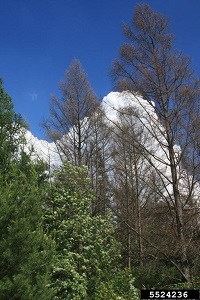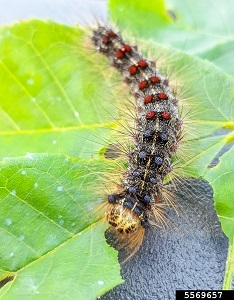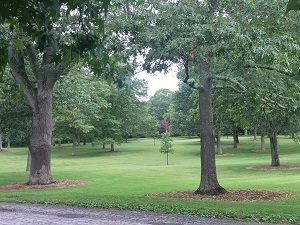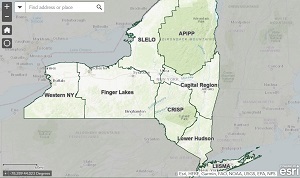June's Forests, Plants, and Land Conservation News
The New York State Department of Environmental Conservation sent this bulletin on 06/24/2021 09:51 AM EDT |
| DEC Delivers - Information to keep you connected and informed from the NYS Department of Environmental Conservation |
| Share or view as a web page || Update preferences or unsubscribe |
Forests, Plants, and Land Conservation News |
This Month's Topics:
Report Dead or Dying Eastern Larch Trees (Tamaracks) in the Adirondacks to DEC
DEC is seeking additional reports of dead or dying eastern larch trees in the Adirondacks to better determine if this is a local infestation or a larger outbreak. If you have seen any in this region, please report it by sending photos and location information to DEC at foresthealth@dec.ny.gov, or by calling your local DEC office and speaking with a forester. You can find tamarack photos and identification tips on the Wild Adirondacks website. Photo of a bare larch tree in summer by Steven Katovich, forestryimages.org 2021 Gypsy Moth Caterpillar Outbreak in New York State
The caterpillars you are seeing now will begin to disappear around mid-July when they pupate and become moths. Spraying insecticides is not effective at this late stage of caterpillar development. This time of year, you may choose to use or make a trap on your trees to catch caterpillars while they are still crawling, though this will not erase the population. Please monitor your traps regularly for unintended wildlife that may pass through. In winter, you can help DEC predict next year's population numbers by conducting egg sampling surveys. In spring, you may scrape egg masses to prevent some hatching, though that will also not erase the population. The spikes in gypsy moth numbers are an unfortunate but cyclical part of NY's forests. You can view DEC's recent Facebook Live about gypsy moths and answers to common questions about them on our Facebook page. For more information on gypsy moths in NY, visit our website. Photo of a gypsy moth caterpillar by Karla Salp, bugwood.org Say No to Mulch VolcanoesHave you seen a mulch volcano this spring? We bet you have! Mulch volcanoes are created when mulch gets piled high against a tree. This traps moisture against the trunk and can lead to decay, pest damage, or even tree death. Proper mulching is easy, and it doesn’t just lead to healthier trees, it also leads to more money in your pocket because you’ll be buying less mulch. You’ll also save money on future tree care costs by preventing pest damage and rot.
For more information on proper tree planting and care, visit DEC’s website. For everything you’ve ever wondered about mulch – and more! – visit the Cornell Cooperative Extension of Suffolk County website. Photo of correct mulching is courtesy of Cornell Cooperative Extension of Suffolk County Volunteer with DEC's Adopt-a-Trailhead ProgramIf you love volunteering and spending time outside, we have the perfect opportunity for you! This past spring, Governor Andrew M. Cuomo launched a new initiative to assist with the stewardship of trailheads across the state and educate trail users before they enter the backcountry. Introduced in the Governor's 2021 State of the State address, the Adopt-a-Trailhead program is managed by DEC and gives the public the opportunity to support State-led efforts to care for state lands and educate fellow visitors on the value of responsible recreation.
After applications are approved, groups and individuals will be assigned to a trailhead in their area. Individuals can apply if they are up for the time commitment, or they can email volunteer.stewardship@dec.ny.gov to get connected with a volunteer group in their area. Participation in the Adopt-a-Trailhead program will include:
For more information or to get involved with the Adopt-a-Trailhead program, visit DEC's website. New #OnesToWatch Map Lists Early Detection Invasive Species by RegionYou probably already know that DEC tracks many different invasive species across the state, but did you know you are our greatest partner in finding and stopping these species? Your eyes on the ground help us not only to locate invasives, but also to find them soon enough for management to be an option. The earlier an infestation is found, the greater our chances are to eradicate it, contain it, or at the very least, slow it down, which buys valuable time to develop better control methods and prepare for its arrival.
For more information on DEC’s #OnesToWatch campaign and the successes we’ve had as a result of people like you getting involved, visit our new Find and Report Invasive Species webpage. Regenerate NY Cost-Share Grants Available for Forest Landowners
Applicants will need to apply through Grants Gateway. Private landowners are encouraged to team up with a cooperating forester who may provide application support. Check out the Regenerate NY webpage on DEC's website for more information. Photo by Leslie Robertson for the National Association of State Foresters Learn About the Importance of Pollinators and How You Can Protect ThemThe New York State Department of Agriculture and Markets, Environmental Conservation (DEC) and New York State Office of Parks, Recreation and Historic Preservation (OPRHP) have affirmed New York's commitment to promoting the health and recovery of the state's pollinator population. For details, check out the updated 2020 Pollination Protection Plan. Join with New York DEC in celebrating Pollinator Week and learn the importance of protecting key pollinator species such as bees, butterflies, and hummingbirds. Latest Buzz: On June 21st, 2021, the U.S. Environmental Protection Agency (EPA) Administrator Michael S. Regan issued a proclamation in support of National Pollinator Week, June 21 - 27, 2021. There is much to learn about these valuable members of New York's ecosystems, as well as many steps your household can take to protect them and to preserve their habitat.
Earn Your Wings and Help Protect Our Pollinators:
Take a Virtual Pollinator Garden Tour made possible through a grant from the NYS Integrated Pest Management with help from Cornell Cooperative Extension of Putnam County. So, let's swarm together and improve pollinator health in both your yard and in the local ecosystem. If you have questions or concerns, email Pest Management or call (518) 402-8788. Urban and Community Forestry Corner2021 ReLeaf Conference The 2021 NYS ReLeaf Conference is almost here! The Western NY Region ReLeaf committee has worked hard to put together a slate of speakers for a virtual conference you won’t want to miss, happening Friday, July 23. There are lots of great presentations on a variety of topics, including trees and health and trees for stormwater management. View the complete list of speakers and conference agenda online, and register with the NYS Urban Forestry Council on their website. The conference is just $10 for students and Council members, and $20 for everyone else. If you’ve wanted to check out a ReLeaf event and haven’t had a chance to, this is your opportunity! Community Highlight - Arbor Day Celebrations Around the State
NYC Urban Forest Agenda Released Forest for All NYC – a new coalition of organizations and groups across NYC including DEC, The Nature Conservancy, NYC Department of Parks and Recreation, Davey Resource Group, New Yorkers for Parks, and many more – released the NYC Urban Forest Agenda which provides a roadmap for NYC’s urban forest. The report is the result of several years of effort by partners to describe a comprehensive vision for the forests of NYC. Read the report and learn more on the Forest for All website. |

 DEC has been receiving reports of dead and quickly-dying eastern larch/tamarack trees (Larix laricina) in the Adirondack region. Upon inspection, we have found the trees to be infested with
DEC has been receiving reports of dead and quickly-dying eastern larch/tamarack trees (Larix laricina) in the Adirondack region. Upon inspection, we have found the trees to be infested with  This spring, DEC has been receiving reports of larger-than-usual gypsy moth populations and leaf damage in several parts of New York State. Gypsy moths are non-native but are naturalized, meaning they will always be around in our forests. Their populations spike in numbers roughly every 10 to 15 years, but these outbreaks are usually ended by natural causes such as disease and predators. Because of this, DEC and its partners typically do not manage it. At this time, DEC does not provide funding for treating gypsy moths on private property.
This spring, DEC has been receiving reports of larger-than-usual gypsy moth populations and leaf damage in several parts of New York State. Gypsy moths are non-native but are naturalized, meaning they will always be around in our forests. Their populations spike in numbers roughly every 10 to 15 years, but these outbreaks are usually ended by natural causes such as disease and predators. Because of this, DEC and its partners typically do not manage it. At this time, DEC does not provide funding for treating gypsy moths on private property.  Follow these tips to keep your new tree healthy when mulching:
Follow these tips to keep your new tree healthy when mulching: Adopt-a-Trailhead volunteers will bolster ongoing efforts to eliminate litter problems and educate trail users about hiker preparedness, thus eliminating the amount of trash left at trailheads and encouraging proper disposal of human waste while in the woods. Volunteers and DEC will continue to encourage hikers to
Adopt-a-Trailhead volunteers will bolster ongoing efforts to eliminate litter problems and educate trail users about hiker preparedness, thus eliminating the amount of trash left at trailheads and encouraging proper disposal of human waste while in the woods. Volunteers and DEC will continue to encourage hikers to 
 Do you own between 10 and 1,000 acres of forest land and have interest in improving your woods? DEC’s Regenerate NY program provides cost-share grants to New York landowners looking to enhance forest regeneration on their property. Landowners who want to plant trees, control invasive species, restore a degraded forest stand, or exclude deer are encouraged to apply for project funding. To find out more about getting funding for your forest,
Do you own between 10 and 1,000 acres of forest land and have interest in improving your woods? DEC’s Regenerate NY program provides cost-share grants to New York landowners looking to enhance forest regeneration on their property. Landowners who want to plant trees, control invasive species, restore a degraded forest stand, or exclude deer are encouraged to apply for project funding. To find out more about getting funding for your forest, 
 Saratoga Springs - The city of Saratoga Springs celebrated Arbor Day this year with a street tree planting to replace a dead tree that had been removed from the same spot. Pictured here are the Department of Public Works (DPW) Commissioner Anthony "Skip" Scirocco and City Arborist (and Southern Adirondack ReLeaf committee co-chair) Steve Lashomb, along with staff from DPW.
Saratoga Springs - The city of Saratoga Springs celebrated Arbor Day this year with a street tree planting to replace a dead tree that had been removed from the same spot. Pictured here are the Department of Public Works (DPW) Commissioner Anthony "Skip" Scirocco and City Arborist (and Southern Adirondack ReLeaf committee co-chair) Steve Lashomb, along with staff from DPW. City of Rochester and Monroe County Parks - The City of Rochester and Monroe County Parks celebrated Arbor Day together with an event and a large tree planting in three county parks that have been impacted by the loss of ash trees from the invasive emerald ash borer. Boy Scouts from the Seneca Waterways Council volunteered to plant 3,200 trees provided by Monroe County Parks and
City of Rochester and Monroe County Parks - The City of Rochester and Monroe County Parks celebrated Arbor Day together with an event and a large tree planting in three county parks that have been impacted by the loss of ash trees from the invasive emerald ash borer. Boy Scouts from the Seneca Waterways Council volunteered to plant 3,200 trees provided by Monroe County Parks and